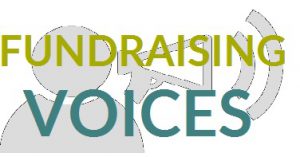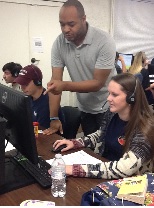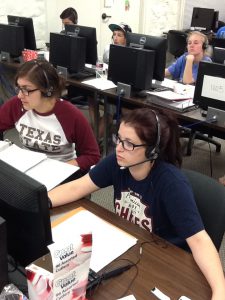fundraising
Fundraising Voices: Recruiting Students and Funds in One Call Center

Combining the enrollment and fundraising outreach takes a lot of organization and a commitment to training the callers, but the returns on both activities have made it well worth the investment. Program center manager Odies Moore talked with me about the strategy behind this innovative approach, how he trains callers, and what it takes to make it work.
Can you explain how you prepare for both fundraising and enrollment calling at the same time?
All of the student supervisors and callers are trained on both types of calling. I usually start all new callers in fundraising. The students tell me that they feel the fundraising calls are more difficult, and I want to give them the most intense thing to start, sort of a boot camp. Callers who prove themselves move over to enrollment calls.
Why do you think the students feel that the fundraising is more difficult than enrollment calls?
More often, they’re talking to people closer to their age in recruiting calls. Fundraising calls also have additional metrics that callers are judged on. We do see some students gravitate toward one type of call or another, but I think it’s very important to have them experience both.
How do you organize a call center for two types of calls?
The center is divided in half, one side for fundraising, the other for enrollment. We have two student supervisors each night who assist. They can both work either division, but they focus on one side for the night. Sitting the callers next to someone who is doing the same type of call as them is helpful. New callers hear how veteran callers deal with fundraising objections and proceed with the call. They can also learn from other callers how to correctly go through the process of an enrollment call. Now, you have to be sure your veteran callers are doing the right thing, or you’ll have a lot of bad calls going out!
What are the qualities you find great enrollment and fundraising callers have in common?
Communication skills are important in both calls. Being able to portray and express the need for the money we are asking for, or the love of the school they attend, is important when talking to prospective donors or prospective students. When choosing callers, you want to find someone who is expressive and persuasive.
When hiring an employee, I usually only look at their name and where they are from before the interview. I want them to tell me about their previous employment and how much they liked or disliked the job. I want to hear their stories about what got them to Texas State and their experiences around town. If they make me want to work for their previous employer or do some of the same things they have done here at school, that’s someone I want talking to alumni or potential students. The ability to have that feeling and energy in your voice gets people excited. What you say has some effect, but how you say it gets results.
Anything else?
Versatility is also important. Fundraising is all about persuasion, and most enrollment calls are more like a survey. With fundraising calls, you can be loose with the script—in fact, it’s encouraged. For enrollment, students need to stick to the script because we’re primarily screening for interest, and asking a question in a persuasive way can skew the outcome. We focus on differentiating between those two types of conversations when we train callers.
What have you learned from combining the enrollment and fundraising efforts in one call center?
You have to think about calling for dollars and enrollment deposits differently. With fundraising, your main goal is to get to a certain dollar amount, or a certain amount of donors in a given time frame. There are different tactics you can use to get to those goals. There are also “x-factors” that can get you where you need to be. A $20,000 pledge can make up some ground for a program struggling to hit the dollar goal.
With enrollment, we’re completing calls in a tight time frame before moving to the next academic program’s list. We want to reach a certain interest level of students but also get through 70 percent or more of the list. The key question is, are these the right students interested in this school and how can we most effectively identify that?
What do student callers learn from the experience?
The students learn a lot of information about Texas State. Not only do they hear about the office of development and advancement, they also learn about admissions and what goes into bringing other students to school here. It gives them a broader understanding of the university as a whole. They also learn to talk in a professional manner to people of all ages, from high school students to people who could be their great grandparents. That’s difficult to do as you move across generations. Translating your message to a high school student is different than translating it to that high school kid’s parents. Finding common ground with young alumni is not the same as talking about Texas State with an alumnus who graduated 30 years ago. Student callers get this experience and become better communicators because of it.
Most of all, student callers gain confidence. Not only are they talking to people they haven’t met, but they are in some form or fashion selling the school they attend.
What recommendations do you have for a college or university looking to combine student recruitment and fundraising in one calling program?
There are a lot of possible benefits from combining the effort and I think this is a great model to have. It can save a university money by sharing resources. Also, you will definitely make enrollment calls to legacy students who have parents who graduated from your college. Those parents might want to be more involved financially if their child is looking into their alma mater. What if an alumni prospect has a son or daughter interested in attending your school? This could help the enrollment office.
One of the biggest recommendations I have is that both departments should have a plan for the year and communicate that plan to each other as it changes. Fundraising and enrollment have to be reactive programs. Knowing if there is a big push for enrollment in April, or a fundraising need in December are important so you can plan. Checking in with each other about changes and needs of the calling program is crucial to making this work.
I had a meeting the other day with the VP of advancement and the assistant VP of enrollment. They told me that having an outside vendor run a joint center is saving them time and meetings. We communicate with both of them about what is happening in the Center. They don’t have to hunt each other down about changes in the calling plan or number of stations needed. They don’t have to worry about each other’s schedule changes and all those things because we do all of that for them and make it work.
We take care of the details and keep the center dialing. They can focus on strategy, which means better results all around.
Thanks, Odies, for providing insight into what a campus can do to combine enrollment and fundraising communications.
Texas State University has done remarkable work with this effort, and it is paying dividends for them. We can help you set up a combined enrollment and fundraising communications effort, the way we have done for other campuses through our CORE Communication Center. Get in touch and we’ll tell you more about how this unique strategy could help with your fundraising and enrollment goals.

